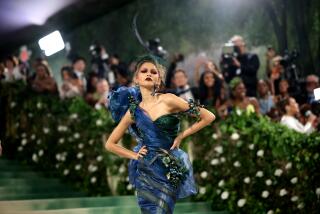DANCE REVIEW : Danza Floricanto Bears Gema Sandoval’s Stamp
Mexican culture is so rich and diverse that any folklorico sampling inevitably reveals less of Mexico itself than the tastes and priorities of the company artistic director making the choices.
Consider the virtually new program by Los Angeles’ own Danza Floricanto U.S.A. at the John Anson Ford Amphitheatre early Sunday evening. Unusual points of focus and a feminist perspective took the dancing far beyond either armchair tourism or Chicano nostalgia. More than ever, director-choreographer Gema Sandoval infused the traditional repertory with her Mexican-American politics, her sense of social history and her appetite for dance-theater.
Not every gamble paid off, but inspired musicianship by both the Mariachi Mexicapan and Armonia Azul ensembles sustained the program through its lapses and sometimes helped it achieve an irresistible vivacity.
Indeed, Sandoval’s ballroom cavalcade “America Tropical” found most of the company dancers looking listless and uncertain in the ornamented box steps of the century-old social dance, the danzon. Not to worry: The playing proved fabulous throughout and the audience-participation finale allowed the local Mexican-American community to demonstrate the danzon properly, in all its glory.
In “La del Rebozo Blanco,” Sandoval attempted to arrange Tamaulipas folk materials into a bittersweet narrative--a kind of ballad drama in which a couple’s relationship on and off the dance floor became more important than the group dancing itself.
Unfortunately, her program notes and spoken introduction revealed key insights that she hadn’t yet managed to put onstage. As a result, the piece emerged sketchy and bland.
More successful and conventional: suites from Chiapas and the Yucatan. Together with the largely familiar Jalisco suite that ended the evening, “Chiapas Lindo” provided the most assured dancing on the program and its sweetness and charm never grew cloying even in the pantomimed flirtation-playlet inserted near the finish.
However, the opening looked drastically over-edited: You scarcely had time to marvel at the women’s dresses (black gossamer with brilliant floral embroidery) before they vanished forever. “Vaqueria en Yucatan” also had its share of arbitrary shifts between sections: junctures breaking the natural flow of a party.
The group Maypole and bottle-balancing segments here may have lacked the joyous, childlike release of the Chiapas animal duets, but they reinforced the concept of community gatherings that Sandoval developed and heightened through much of the program.
Other folklorists portray Mexican culture as a vast panorama or a series of startling dramatic contrasts. Increasingly, however, Sandoval presents the dances as flash points illuminating and affirming group identity. “La del Rebozo Blanco” tries to show individual needs in conflict with the group but, significantly and perhaps inevitably, it is only her depiction of the group that achieves maximum authority.
More to Read
The biggest entertainment stories
Get our big stories about Hollywood, film, television, music, arts, culture and more right in your inbox as soon as they publish.
You may occasionally receive promotional content from the Los Angeles Times.






